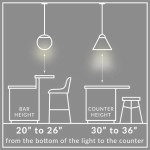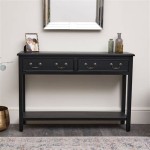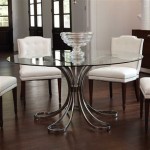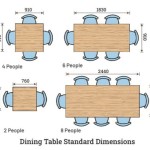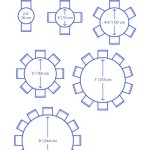Centerpieces for Round Dining Room Tables: A Guide to Elevated Aesthetics
The dining room, often the heart of a home, serves as a space for shared meals, engaging conversations, and memorable gatherings. The dining table, therefore, becomes a focal point, deserving of careful consideration when it comes to its aesthetic presentation. A well-chosen centerpiece can transform a simple round dining room table into a captivating and inviting space. This article explores various centerpiece options suitable for round tables, focusing on key design principles and practical considerations.
Understanding the Round Table Dynamic
Round dining tables present unique opportunities and challenges when selecting a centerpiece. Unlike rectangular tables, which offer a linear space for arrangement, round tables necessitate a centerpiece that complements the circular form and promotes visual balance. The key is to avoid anything overly angular or bulky that might disrupt the table's natural harmony. Centerpieces should enhance the table's shape, not compete with it.
Scale is paramount. A centerpiece dwarfed by the table will appear lost, while one that is too large will overwhelm the space and obstruct conversation. The height of the centerpiece is also crucial. While dramatic, towering arrangements can hinder visibility across the table, creating a barrier between diners. Consider the typical usage of the table. Is it primarily for formal dining, casual meals, or a multi-purpose space? The answer will influence the formality and size of the centerpiece.
Ultimately, the goal is to create a visually appealing arrangement that enhances the dining experience without compromising functionality. This requires a thoughtful approach, considering the table's dimensions, the room's overall decor, and the intended purpose of the space.
Exploring Centerpiece Options
The options for centerpieces on round dining room tables are virtually limitless, ranging from traditional floral arrangements to more contemporary and abstract designs. Each style offers a distinct aesthetic and can be tailored to complement specific tastes and interior design schemes.
Floral Arrangements: A classic choice, floral arrangements can bring vibrancy and life to a dining room. For round tables, consider using a single, substantial vase filled with a generous bouquet. Alternatively, a cluster of smaller vases, each containing a few blooms, can create a more informal and whimsical effect. Choose flowers that complement the room's color palette and consider the seasonality of the blooms.
Candle Displays: Candles offer a warm and inviting ambiance, particularly suitable for evening gatherings. A group of varying height pillar candles placed on a decorative tray or platter creates a simple yet elegant centerpiece. Alternatively, a candelabra, either traditional or modern in design, can serve as a striking focal point. Always ensure that candles are placed away from flammable materials and are extinguished before leaving the room unattended.
Fruit and Vegetable Displays: For a more rustic or organic aesthetic, consider using fruits and vegetables as a centerpiece. A bowl of vibrant citrus fruits, a stack of seasonal gourds, or a collection of artichokes can add a touch of natural beauty to the dining table. This option is particularly well-suited for kitchens or dining rooms with a farmhouse or country-style decor. Replace the produce regularly to maintain freshness and prevent spoilage.
Sculptural Objects: Abstract sculptures or artful decorative objects can serve as sophisticated and contemporary centerpieces. These pieces can add a touch of personality and visual interest to the dining table. Choose objects that complement the room's overall style and scale them appropriately to the table's size. Ensure that the chosen object does not obstruct views across the table.
Natural Elements: Incorporating natural elements such as stones, branches, or driftwood can create a calming and organic atmosphere. A collection of river stones, a gnarled branch displayed in a vase, or a piece of driftwood placed on a natural fiber mat can add a touch of the outdoors to the dining room. These elements are particularly well-suited for dining rooms with a minimalist or nature-inspired design.
The chosen centerpiece should reflect personal style and complement the overall aesthetic of the dining room. Experimentation with different materials, textures, and colors is encouraged to find the perfect arrangement for the space.
Key Design Considerations
Beyond the specific type of centerpiece, several design considerations play a crucial role in creating a harmonious and visually appealing arrangement. These considerations include color, texture, height, and negative space.
Color Harmony: The colors of the centerpiece should complement the existing color scheme of the dining room. Choose colors that either harmonize with or provide a subtle contrast to the walls, flooring, and furniture. Monochromatic color schemes, using variations of a single color, can create a sophisticated and cohesive look. Alternatively, complementary color schemes, using colors opposite each other on the color wheel, can add a vibrant and dynamic touch.
Textural Contrast: Incorporating different textures can add depth and visual interest to the centerpiece. Combine smooth and rough textures, such as polished stones with rustic wood, or delicate flowers with coarse foliage. This textural contrast creates a more engaging and tactile experience.
Height Variation: As previously mentioned, height is a crucial consideration. Aim for a centerpiece that is either low enough to allow for unobstructed conversation or tall enough to make a statement without blocking views. Consider using a tiered arrangement, with varying heights of elements, to create visual interest while minimizing obstruction.
Negative Space: The concept of negative space, the empty areas around and within the centerpiece, is just as important as the elements themselves. Allowing for ample negative space prevents the arrangement from feeling cluttered or overwhelming. It also helps to highlight the individual elements and allows the eye to rest.
Seasonality: Adapting the centerpiece to reflect the changing seasons can keep the dining room looking fresh and inviting throughout the year. Use spring blooms in the spring, summery fruits in the summer, autumnal foliage in the fall, and winter greenery in the winter. This seasonal adaptation adds a touch of nature and keeps the dining room aligned with the rhythms of the year.
Careful attention to these design considerations will elevate the centerpiece from a simple decoration to a thoughtfully curated element that enhances the overall aesthetic of the dining room.
Practical Considerations for Everyday Use
While aesthetics are important, practicality should also be considered when selecting a centerpiece for a round dining room table. The centerpiece should be functional and not impede the everyday use of the table.
Size and Scale: Ensure the centerpiece does not take up too much space on the table, leaving ample room for place settings and serving dishes. Consider the typical number of diners and the amount of space required for each person. A smaller, more streamlined centerpiece may be preferable for smaller tables or frequent gatherings.
Durability: If the centerpiece will be used frequently, choose materials that are durable and easy to clean. Avoid delicate or fragile items that are likely to break or be damaged. Consider using materials that can withstand spills and stains, such as glass, metal, or waterproof fabrics.
Maintenance: The amount of maintenance required for the centerpiece should also be considered. Fresh floral arrangements require regular watering and trimming, while fruit and vegetable displays need to be monitored for spoilage. Opt for low-maintenance options if time is limited or if the centerpiece is intended for long-term display. Artificial flowers, dried botanicals, or sculptural objects require minimal upkeep.
Visibility: As previously mentioned, ensure that the centerpiece does not obstruct views across the table, hindering conversation and interaction. Choose a centerpiece that is either low enough or tall and slender enough to allow for unobstructed sightlines. This is particularly important for formal dining settings where conversation is a key element of the experience.
Storage: When not in use, the centerpiece should be easy to store. Consider the size and shape of the centerpiece and ensure that there is adequate storage space available. Modular centerpieces that can be disassembled for storage may be a practical option.
By taking these practical considerations into account, the centerpiece can be both aesthetically pleasing and functional, enhancing the dining experience without compromising the everyday use of the table.
Ultimately, the perfect centerpiece for a round dining room table is one that reflects personal style, complements the room's decor, and enhances the overall dining experience. This article has explored various centerpiece options, key design considerations, and practical concerns to guide the selection process.

Gorgeous Round Table Centerpiece Ideas For Summer Perfecting Places

Gorgeous Round Table Centerpiece Ideas For Summer Perfecting Places

30 Spectacular Round Dining Table Centerpiece Ideas To Enhance Your Home

Gorgeous Round Table Centerpiece Ideas For Summer Perfecting Places

Gorgeous Round Table Centerpiece Ideas For Summer Perfecting Places

35 Admirable Ideas For Decorating A Round Dining Table

Beautiful And Easy Dining Room Table Centerpiece Ideas Stonegable

Why You May Need A Round Dining Table

10 Stunning Decorating Ideas To Style A Round Dining Room Table

15 Great Decor Ideas For Kitchen Table Centerpieces

